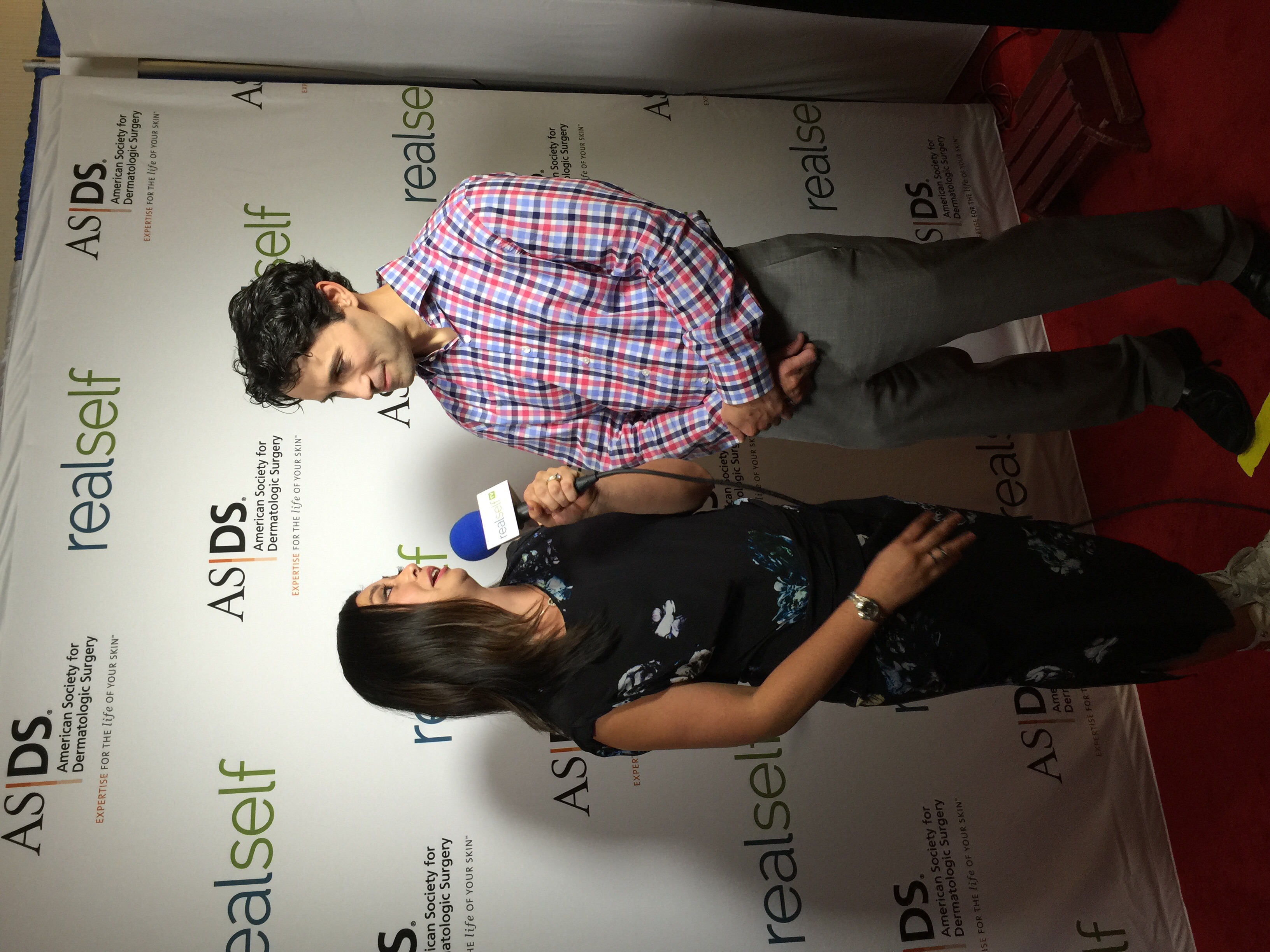
One of the primary reasons women and men alike begin to show signs of aging is loss of the skin’s structural support (especially collagen).
Denver’s AboutSkin Dermatology team regularly provides consultations with patients who want to address any of a number of facial changes, including volume loss and the development of nasolabial folds and similar creases, thin lips, and facial hollows. All of these cosmetic issues can be attributed to collagen loss and changes in the structural support of the skin. Fortunately, they can also all be minimized and addressed with dermal fillers.
Fillers can restore volume in areas of the face, hands, and chest. Dr. Joel Cohen of AboutSkin Dermatology has participated in numerous clinical trials on dermal fillers—including Restylane®, Restylane Lyft® (face and hands), Radiesse® (cheek and jawline), Voluma® (cheek), Juvederm® (lip, nasolabial folds, and marionette area), etc.

There are many brands of dermal fillers available. Some of them range from Juvederm® to Restylane® and Radiesse®. If you want to find out more about the dermal fillers that are available right now or if you want to make sure that you’re getting the best one for you then our team at Levy Dermatology can help you with that.
What Are Dermal Fillers?
Dermal fillers are soft tissue injectables. They are injected into the skin at various depths and this helps to fill folds and fine lines. It also gives the face a lot of volume while augmenting facial features. This helps to give you a much smoother appearance. Dermal fillers can last up to two years, depending on the product and injection site.
Types Of Dermal Fillers And Application For Each
There are many different types of dermal fillers. The ones that we have available at Levy Dermatology can be found below.
Juvederm®
Juvederm® is FDA-approved. It’s also made out of hyaluronic acid, which occurs naturally in the skin. This acid is able to restore volume while also eliminating severe wrinkles. This product can also be used to boost lip volume. The results are both immediate and natural.
Juvederm® Vollure
Juvederm® Vollure is a hyaluronic acid filler and it’s much softer when compared to other fillers. This means that it is able to provide great results with minimal swelling and bruising. This filler is used to treat lines that form around the mouth, the nasolabial folds, the marionette lines, and areas in the lower face.
Juvederm® Voluma
Juvederm® Voluma is great for correcting age-related volume loss that may occur in the mid-face. It’s also ideal for adding volume to the upper cheek area to lift and contour for a natural and subtle appearance. This filler can easily last up to two years with minimal side effects.
Juvederm® Volbella
Juvederm® Volbella is much more viscous with subtle volume being added without that stiff feeling. It’s great for smoker’s lines and adding volume to thinning lips. The results can be seen immediately post injection.
Restylane®
Restylane® is composed of hyaluronic acids and it’s biocompatible too. It corrects facial wrinkles and volume loss with ease.
Restylane® Kysse
Restylane® Kysse Each molecule binds to the water, and this helps to plump and define the lips properly. Results can last up to 6-8 months.
Radiesse®
Radiesse® is an injectable that is designed to give long-term results. One-time treatments work very well to add structure and volume.
Belotero Balance®
Belotero Balance® is an injection that is ideal for thinner areas of the face like the under-eye area. Results can last up to 6- 8 months.
Benefits Of Dermal Fillers
There are many benefits to using dermal fillers. You’ll see immediate improvement in your facial contours and you may even find that your confidence is boosted dramatically.
Am I A Candidate For Dermal Fillers?
Good candidates for fillers will have severe folds, deep wrinkles or volume loss.

Schaumburg dermatologists Dr. Jeffrey Hsu and Dr. Ashish Bhatia of Oak Dermatology provide a helpful summary of the different uses and benefits of neurotoxins (Botox, Dysport, Xeomin) and dermal fillers (Juvederm, Restylane and others).
They describe how neurotoxins are particularly helpful for reducing the appearance of wrinkles where there is muscle movement, such as along the forehead, between the eyebrows, and the "crow's feet" wrinkles lext to the eyes.
Dermal fillers, in contrast, fill in areas of lost volume as can occur with aging, such as on the cheeks or the temples. Dermal Fillers may also be used to "fill in" the tissue beneath wrinkles to reduce their appearance.
Dr. Hsu and Dr. Bhatia make it clear that the decision to use one form of treatment over another depends on the patient's particular needs and and that sometimes both a neurotoxin and dermal filler may be used to achieve the desired outcome. "Sometimes Botox, sometimes filler, sometimes both."
Restylane® is a very popular dermal filler used to reduce the appearance of lines and wrinkles on the face, fill hollows, and to enhance the lips. It is made of hyaluronic acid, a product naturally found in our skin. When injected into lines and depressions, it adds volume and reduces their appearance.
In order to minimize discomfort, Restylane is mixed with an anesthetic and ice packs are applied to the skin prior to treatment.
Each treatment takes about 20 – 40 minutes depending on how much needs to be filled.
The results from Restylane usually last 6 – 9 months. Many patients find that returning for a touch-up treatment every 6 months provides the best results since they never let their Restylane get fully absorbed before getting more.
The side effects of Restylane treatment are low and consist primarily of bruising and swelling at the injection sites. Avoiding aspirin, ibuprofen, vitamin E, fish oil, and other non-prescription blood thinners will minimize the risk of bruising. In addition, patients should avoid exaggerated facial movements for a day or two after receiving treatment.
A much less likely side effect is infection, and allergy is extremely rare.

As our skin ages, it loses support and volume. This leads to the formation of wrinkles and folds. Dermal fillers are commonly used to reduce or eliminate wrinkles, smooth depressed scars, enhance lips and replace soft-tissue volume loss.
A dermal filler is injected beneath the surface of the skin where it temporarily plumps and smoothes the skin. There are several classes of FDA-approved dermal fillers, the most common being hyaluronic acid and calcium hydroxyl apatite-based fillers. Each of these products has different properties and characteristics.
I generally recommend the hyaluronic acid fillers, such as Juvederm® and Restylane®. Hyaluronic acid is a natural component of human skin and is the framework in which skin cells live. All hyaluronic acid products bind water and give the skin greater volume. These products offer a combination of safety, smooth and natural appearance, and good duration of benefits. A hyaluronic acid filler, such as Restylane® or Juvederm® can be dissolved with a readily available and safe enzyme injection. Although this is rarely needed, it is reassuring to have that option available.
The improved appearance provided by hyaluronic acid filler usually lasts about 9 months. There are other dermal fillers derived from other substances that provide long-lasting results, such as poly-L-lactic acid. The idea of getting fewer injections may sound appealing at first, but consider what would happen if you had a bad reaction to such a filler, or if you weren’t happy with the results?
Source: Vivacare
Last updated : 2/10/2023